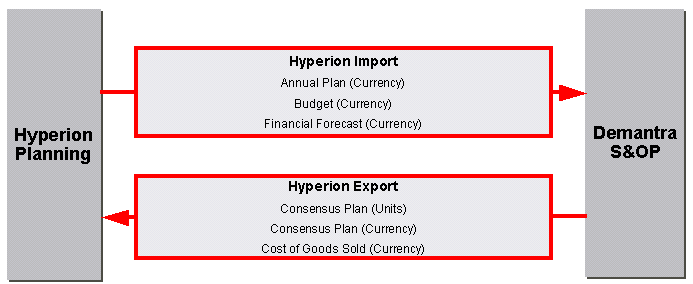Demantra Sales and Operations Planning to Hyperion Integration
This chapter describes how Demantra Sales and Operations Planning integrates with Hyperion.
This chapter covers the following topics:
- Demantra Sales and Operations Planning - Hyperion Planning Integration Overview
- Architectural Process
- Integration Points Overview
- Business Processes
Demantra Sales and Operations Planning - Hyperion Planning Integration Overview
Accurately predicting revenue and operating performance is a daunting challenge facing many enterprises today. Despite awareness of the adverse impact of missed forecasts on their business plans, the most common solution for budgeting and planning is still a disconnected spreadsheet that makes the planning process unreliable and inefficient. The resulting long budget cycles and forecasting inaccuracies prevent responsiveness to change, causing companies to miss business opportunities while wasting money and resources on declining business segments. By integrating Oracle Hyperion Planning and Oracle Demantra, top-down planning and bottom-up planning can be linked to improve the accuracy and reliability of annual plans, budgets and financial forecasts.
The Demantra S&OP - Hyperion Planning integration includes a set of interfaces, pre-seeded worksheets, workflows, methods and data series.
Architectural Process
Oracle Hyperion Planning and Oracle Demantra exchange information through the use of the Oracle Data Integrator (ODI) Adapter for Hyperion Planning, the Oracle Data Integrator (ODI) to transform the data, and Oracle Demantra integration interfaces and workflows as shown in the following diagram:

The integration processes can be run when required from Demantra worksheets, workflows or ODI.
Integration Points Overview
The following integration points are part of the integration between the Oracle Demantra Sales and Operations Planning module and Hyperion Planning applications.

The following table details the frequency and recommended load for each integration point is detailed below:
| Interface | Flow | Suggested Frequency |
|---|---|---|
| Hyperion Import | Hyperion to Demantra | Quarterly or monthly |
| Hyperion Export | Demantra to Hyperion | Weekly or monthly |
Business Processes
-
The Chief Financial Officer develops the annual plan using a bottom-up planning process followed by top-down budget. The financial forecast is a refinement of the budget and includes actuals for historical periods.
-
The annual plan, budget and financial forecast (all currency) are exported and used in Demantra S&OP as financial performance targets to compare with the consensus forecast (in currency).
-
The S&OP Manager compares the financial forecast with the Demantra baseline forecast to identify gaps between the revenue predicted by the Demantra’s bottom-up forecast and Hyperion’s top-down financial plan.
-
A consensus forecast is developed collaboratively in Demantra S&OP
-
To increase demand and close revenue gaps, promotions are adjusted or created in Demantra’s Promotion Trade Planning. A demand plan and a supply plan are generated.
-
Value Chain Planning is used to balance constrained supply and unconstrained demand by evaluating costs and constraints. A feasible solution is returned to Demantra S&OP
-
Additional capacity planning is performed in Demantra S&OP The resulting consensus forecast (currency and units) and cost of goods sold (currency) are exported from Demantra to Hyperion weekly (or another regular frequency).
-
Revenue and profitability targets are monitored in Hyperion.
For more information about the S&OP - Hyperion Planning Integration, please refer to the following documents:
-
Oracle Application Integration Architecture 2.4: Installation and Upgrade Guide
-
Oracle Demantra Sales and Operations Planning Integration to Hyperion Planning 2.4 – Implementation Guide